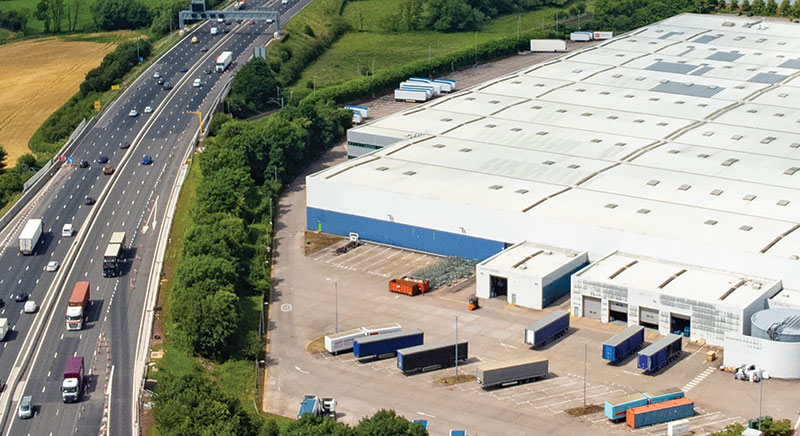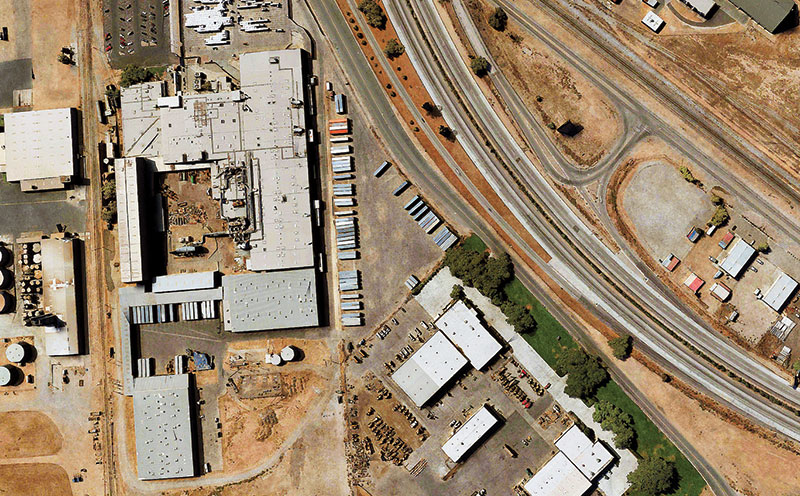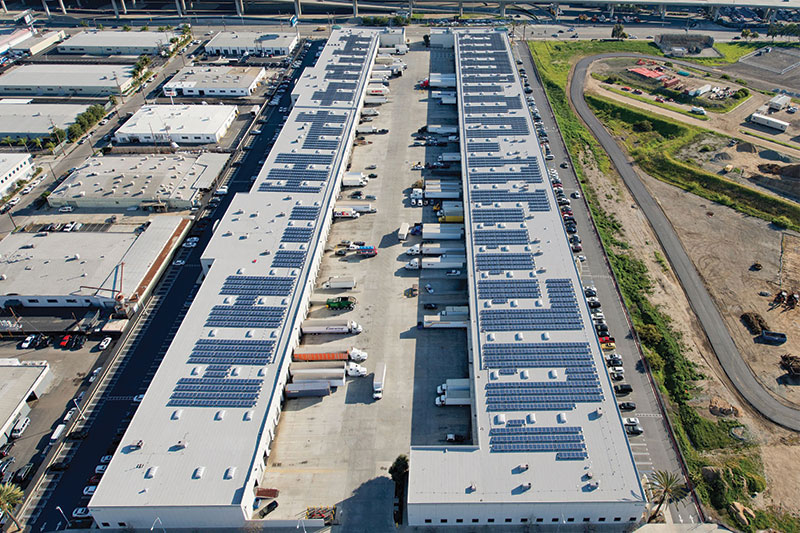Industrial real estate in short supply—much like the products it stocks
Faced with product shortages, today not only are shippers looking to replenish shelves, but the movement from just-in-time inventory management to safety stock arrangements is causing an uptick in storage needs.
As the nation comes out of the perils of COVID-19, supply chains and inventory levels are being tested in ways never envisioned. As a result, companies are re-thinking their supply chains and the resiliency of their inventories in all aspects of their operations. This includes a hard look at warehousing and the need for more space.
Prior to the pandemic, the industrial real estate market, which includes warehouses and distribution centers (DCs), was already on steroids, pushing further to its highest peak. Among the factors affecting the surge was the mammoth shift to online shopping last year and third-party logistics (3PL) providers looking to expand their footprints to accommodate this trend. E-commerce alone accounted for 16% of total leasing in 2020, JLL reports.
“The pandemic sent shockwaves to the supply chain, forcing retailers to look at how they track and stock inventory,” say Mehtab Randhawa, director, and Kelsey Rogers, senior analyst, of JLL Industrial Research in a statement.
New technology aimed at tracking inventory and planning the logistics for distribution also played a major role in changing consumer expectations regarding delivery times, they add.
Faced with product shortages, today not only are shippers looking to replenish shelves, the movement from just-in-time inventory management to safety stock arrangements is causing an uptick in storage needs. Consequently, JLL analysts see 2021 net absorption having the potential to surpass 2020 by a landslide. Real estate experts reported vacancy rates hovering near historic lows around 5% early this year.
As a result, shippers are having an increasingly difficult time finding warehouse and distribution space given tight market conditions not seen in years. Market demand, which began to explode in mid-2020, is expected to continue at an unprecedented pace throughout 2021, JLL says.
“High land values, limited land to build, lack of available product to lease, as well as zoning barriers have created challenges for shippers looking to set up space,” say the JLL analysts.
Retail conversions offer alternatives for fulfillment
The boom in e-commerce has spurred last touch, speed-to-market logistics and added to the overwhelming demand for fulfillment real estate. “Supply can’t keep up with the demand,” says Rob Antrobius, Prologis SVP and market officer, Southern California.
The reasons, he notes: the supply of well-located industrial land is shrinking due to conversions to office and residential real estate, and warehouses are getting bigger, particularly for e-commerce companies that need more space due to deeper inventory levels, space-intensive shipping operations, and returns processing.
Compounding this are the record vacancy rates in all sizes and classes of property that continue to hover at record levels.
With the pandemic accelerating the retail evolution, more people are shopping online. Antrobius notes how globally, e-commerce penetration increased at an outsized rate of 390 basis points in 2020, equal to roughly five years of adoption.
“Because e-commerce requires more industrial space than in-person shopping, Prologis expects the need for an incremental 125 msf of logistics space or more per year through 2025 in the United States and Europe,” he says.
Another driver is corporate reassessment of inventory levels. “Given the supply chain disruptions in the last year, companies are moving from the leaner ‘just-in-
time’ model to more resilient ‘just-in-case’ operations,” Antrobius says. “This shift in supply chain operations could drive inventories up by more than 5% to 10%.”
In the U.S., Prologis Research estimates this shift could create create 57 msf to 114 msf of additional logistics demand per year over the next five years without accounting for a rise in sales.
Converted vacant shopping centers could be a solution. The supply of retail space outweighs current and anticipated future demand for retail space. A recent report from Prologis notes, however, that economic, political, physical and legal factors are the biggest hurdles in getting conversions done.
The e-commerce boom is also leading some companies to consider retail conversions for hyper-local fulfillment centers in urban areas either downtown or close to the population core to meet last-touch, last-mile logistics needs.
“This conversion trend is relatively new. However, to meet demand, the idea of converting retail to fulfillment space/mini warehouse is growing with location being a primary driver for this push,” co-write Mehtab Randhawa, director, and Kelsey Rogers, senior analyst, of JLL Industrial Research in a statement. “As consumer shopping continues to morph, we could see more mixed uses to meet the quickly changing habits and expectations. However, comparing it to overall industrial activity conversions make up a small portion of it.”
Here too, zoning and use restrictions are roadblocks in converting under-utilized retail, particularly in dense, urban logistics markets, they say.
“This is not to say that it won’t happen or that we won’t continue to look at opportunities,” Schnur says. “But the reality is that the headlines about the few that do happen will far dominate the reality of what is happening on the ground.”
He also notes how locations—such as last-mile in Dallas versus last-mile in Manhattan—differ vastly. “One may be five miles and one may be five blocks,” he says. “Logistics demand is very strong in nearly all markets where large population centers are being served. Local fulfillment of goods is location dependent and not all facilities can work operationally.”
- Karen E. Thuermer, Contributing Editor
With demand outpacing new supply deliveries, Steve Schnur, COO, Duke Realty, believes vacancy will fall even further from its record lows in the mid-4% range. He maintains rents will continue to accelerate in nearly all markets.
Real estate experts agree. “Industrial vacancy rate declined 30-basis points [bps] quarter-over quarter, coming in at 4.9% at the end of the first quarter of 2021,” says Carolyn Salzer, director, Americas head of logistics and industrial research at Cushman & Wakefield. “Vacancy remained flat year over year, and, the vacancy rate is now 170 bps below the 10-year historical average of 6.6% for all product types.”
Cushman & Wakefield finds that the current industrial construction pipeline has reached 397.1 million square feet (msf) with no sign of abating. “That’s a new record high for the market,” Salzer says. “Of the industrial product under construction, 376.5 msf (94.8%) is warehouse/distribution product. The pipeline has now expanded 9.1% over the fourth quarter of 2020—the most recent quarter to hold the title of record high pipeline—and nearly 21% over the first quarter of 2020.”
JLL’s analysts note how the industrial development pipeline is extraordinarily strong, with almost 50% of projects currently under construction being pre-leased. “There is a vast amount of demand, but a limited supply of land and industrial sites for users,” they say.
Red hot markets
Few markets across the nation are missing out on this real estate boom. As was the case in 2020, however, the South continues to offer the largest construction pipeline, reports Cushman & Wakefield. It reports more than 167 msf (42.1% of the total pipeline) is under construction as of the first quarter of 2021 and that the hottest markets for product under construction are Dallas/Fort Worth (24.6 msf), Chicago (22.8 msf), the Pennsylvania I-81/I-78 distribution corridor (20.8 msf), Houston (19.8 msf), and Inland Empire (18.7 msf).
“The majority of the space under construction is highly concentrated in primary markets with a few larger secondary markets developing new space,” remarks Salzer. “It’s difficult for everyone to find space at the moment.”
Duke Realty’s Schnur agrees: “It’s hard to point to any area in the United States and say that it’s ‘soft’ from a logistics demand standpoint.” But he adds: “If I had to pick one city where activity hasn’t been as strong as many of the other markets, it would be Houston.”
JLL Industrial Research cites gateway points to major population centers as continuing to be amongst the hottest industrial markets. Good examples are Los Angeles and locations in New Jersey outside New York City.

“Traditionally, warehouse and distribution facilities have been located close to the freight distribution system, including ports, airports, trucking and inland port hubs,” reports JLL’s Randhawa and Rogers. “We are now seeing demand expand to other port markets like Savannah and centrally located cities like Columbus.”
Case in point: In November, World Distribution Services (WDS) opened its second facility in Savannah, a 280,000 square-foot DC. At the time, Cushman & Wakefield reported that the Savannah market comprised of 79 msf of industrial space with another 8.7 msf under construction for an 11% increase in inventory. Cliff Pyron, COO at the Georgia Ports Authority, noted that Savannah has enough land permitted for private development to accommodate another 130 msf of distribution center space within 30 miles of the port—nearly twice the area’s current industrial space.
Matt McCollister, SVP of economic development at One Columbus reveals that his organization is seeing a wide range of bulk industrial square footage requirements from companies in the Columbus, Ohio, region, typically starting at 150,000 square feet with some firms seeking more than 1 msf. “Companies are looking to use these facilities predominantly for e-commerce fulfillment,” he says.
To meet this demand, developers have been very active in the Columbus region over the last 18 months, adding millions of square feet of speculative warehouse and distribution space. A May 2021 statement from CBRE reports that a total of 15 bulk industrial buildings offering nearly 9.5 msf had been completed or started construction in 2021.
“Sixty-seven percent of the space had already been leased at the time of the report,” McCollister says. “The buildings range from 200,000 to 1.2 msf.”
Cushman & Wakefield finds the tightest markets continue to be Orange County, Los Angeles, Philadelphia, central New Jersey, Nashville, Boise, Hampton Roads, Reno and Tulsa—all of which reported vacancy rates at 2.8% or lower in the first quarter of 2021. “More broadly, overall vacancy rates remained lowest in the West and Northeast regions at 4.1% and 4.5%, respectively,” Salzer says.
Unfolding developments
While demand is still going strong, Salzer points to headwinds in the industry, the major ones being construction material shortages and high prices for those materials.
“There is a strong need for concrete/cement and steel in industrial market, and prices are skyrocketing. Commodities are in high demand,” says Salzer. “Developers are looking to keep building, but not having the materials to do so will slow them down.”
JLL’s Randhawa and Rogers say there are additional factors affecting development: high land values, limited land to build, lack of available product to lease, and zoning barriers.
Strong industrial markets that are facing shortages of inventory are causing some locations to introduce new measures to foster new development. One is Sun Corridor Inc., which represents Arizona’s City of Tucson, Pima County, Pinal County, Cochise County, Santa Cruz County, and the surrounding municipalities.
Joe Snell, Sun Corridor president and CEO, explains how his group offers “built to suit” (BTS) options to help developers meet the operational and corporate needs of their clients. It is working to speed up timelines for approvals. It has also created a shovel ready subcommittee tasked with identifying shovel-ready sites; evaluating gaps and determining what investments are needed; and strategically marketing those sites to developers and other stakeholders.

To make the buildings even more efficient, Duke Realty’s Schnur adds that more innovative warehouse design concerning layout and use is being implemented.
“Today, you see more businesses utilizing multiple levels within a warehouse, larger staging areas outside the building, and massive investments in power and technology to accommodate materials handling equipment,” Snell notes. “You also see significant investment in LEED or environmentally conscious development.”
Schnur believes these trends will continue and become more pronounced as clients consider warehouse locations and operations more critically than ever before. And as the saying goes: “What goes up must come down.” This hot trend cannot last forever.

Article Topics
Warehouse News & Resources
The Ultimate WMS Checklist: Find the Perfect Fit 40th Annual Salary Survey: Salary and satisfaction up Data Capture: Bar coding’s new companions Salary Survey: Pay, satisfaction, youth on the rise Examining the impact of the Taiwan earthquake on global supply chain operations Reverse Logistics: Best Practices for Efficient Distribution Center Returns Exploring Customized Forklift Solutions More WarehouseLatest in Logistics
LM Podcast Series: Assessing the freight transportation and logistics markets with Tom Nightingale, AFS Logistics Investor expectations continue to influence supply chain decision-making The Next Big Steps in Supply Chain Digitalization Warehouse/DC Automation & Technology: Time to gain a competitive advantage The Ultimate WMS Checklist: Find the Perfect Fit Under-21 driver pilot program a bust with fleets as FMCSA seeks changes Diesel back over $4 a gallon; Mideast tensions, other worries cited More LogisticsSubscribe to Logistics Management Magazine

Find out what the world's most innovative companies are doing to improve productivity in their plants and distribution centers.
Start your FREE subscription today.
April 2023 Logistics Management

Latest Resources
















